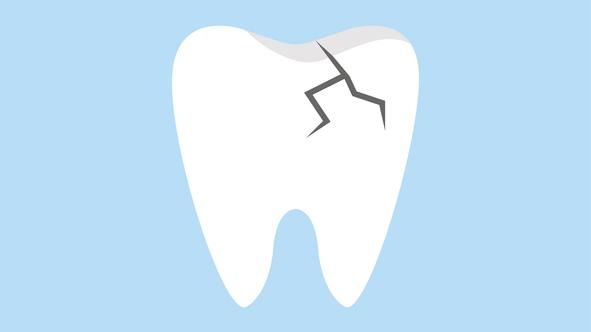Can You Crack a Tooth From Teeth Grinding?

Teeth grinding, scientifically known as bruxism, is a common dental issue that affects millions of people worldwide. While grinding your teeth may seem harmless, it can lead to various dental problems, including cracked or damaged teeth. Understand the risks associated with teeth grinding, its impact on dental health, and the potential solution of dental implants for cracked teeth.
Understanding Teeth Grinding (Bruxism)
Typically, teeth grinding occurs involuntarily during sleep, although some individuals may grind their teeth while awake. It often goes unnoticed until symptoms or dental damage become evident. There are two primary types of bruxism:
Awake Bruxism
Awake bruxism is characterized by clenching and grinding of teeth while conscious. It is often linked to stress, anxiety, or tension and may occur subconsciously during the day.
Sleep Bruxism
Sleep bruxism occurs during sleep and is often associated with sleep disorders, misaligned teeth, or other underlying factors. Many people with sleep bruxism are unaware of their condition until a dentist diagnoses it.
Risks of Teeth Grinding
Teeth grinding poses several risks to dental health, including:
- Tooth Damage: The constant friction and pressure from grinding can wear down the enamel, leading to tooth damage, chips, or cracks.
- Jaw Pain & TMJ Disorders: Bruxism stresses the jaw joints, potentially causing temporomandibular joint (TMJ) disorders. Symptoms may include jaw pain, headaches, and difficulty opening or closing the mouth.
- Gum Recession: Bruxism can exert force on the gums, potentially leading to gum recession and exposing the tooth roots. It can cause tooth sensitivity and aesthetic concerns.
- Sleep Disruption: For individuals with sleep bruxism, the noise generated by grinding can disturb their sleep or sleep partners.
- Tooth Cracks: One of the most concerning risks is the development of cracks in teeth. Cracked teeth can lead to severe pain, infection, and tooth loss if left untreated.
Detecting Cracked Teeth Due to Bruxism
Cracked teeth can be challenging to diagnose, as the symptoms may mimic other dental issues. Here are signs to look out for:
- Pain While Chewing: Sharp or shooting pain when chewing or biting down.
- Sensitivity: Increased tooth sensitivity to hot, cold, or sweet stimuli.
- Pain Relief: Pain may subside when pressure is released temporarily.
- Visible Cracks: Sometimes, you may see or feel the cracks on the tooth's surface.
If you experience these symptoms, you must consult a dentist promptly for a comprehensive evaluation.
Evaluation & Treatment Plan
When a dentist diagnoses a cracked tooth, they will evaluate the extent of the damage. For minor cracks, solutions like dental bonding or a dental crown may be suitable. However, severe cracks that extend below the gum line or result in tooth loss may require more extensive treatment.
Extraction & Implant Placement
In cases where the cracked tooth cannot be saved, extraction is necessary. After extraction, your dentist may recommend dental implants as a replacement option. Dental implants are durable, natural-looking prosthetics that provide excellent functionality and aesthetics.
Benefits of Dental Implants
- Stability: Dental implants are surgically placed into the jawbone, providing stability and preventing neighbouring teeth from shifting.
- Natural Appearance: Implants look and feel like natural teeth, enhancing your smile's aesthetics.
- Longevity: With proper care, dental implants can last a lifetime, making them a cost-effective solution in the long run.
- Functional Restoration: Implants allow you to chew and speak comfortably, restoring full dental function.
Dental Implant Procedure: What to Expect
The dental implant procedure typically involves several steps:
- Surgical Placement: A titanium implant is surgically placed into the jawbone, serving as a sturdy foundation for the replacement tooth.
- Healing Period: The implant integrates with the jawbone during a healing period, which may take several months.
- Abutment Placement: Once the implant has fused with the bone, an abutment is attached to connect the implant to the replacement tooth.
- Crown Placement: Finally, a custom-made dental crown is affixed to the abutment, completing the restoration.
Preventing Teeth Grinding & Cracked Teeth
- Night Guards: For individuals with sleep bruxism, a night guard or splint can be an effective preventive measure. These custom-fitted devices create a barrier between the upper and lower teeth, reducing the impact of grinding.
- Stress Management: Stress reduction techniques such as meditation, yoga, and counselling can help manage awake bruxism caused by stress or anxiety.
- Lifestyle Adjustments: Limiting caffeine and alcohol intake, avoiding chewing on non-food items (e.g., pens), and maintaining good oral hygiene practices can reduce the risk of bruxism and tooth damage.
- Dental Checkups: Regular dental checkups are essential for early detection and treatment of dental issues. Dentists can monitor the condition of your teeth and recommend preventive measures.
Teeth grinding is a common concern that can lead to cracked teeth and dental problems. If you suspect that you're grinding your teeth, it's essential to seek professional dental care promptly. Early intervention can help prevent further damage and preserve your dental health. In cases where a cracked tooth cannot be saved, dental implants offer a reliable and aesthetically pleasing solution. By addressing teeth grinding and its potential consequences proactively, you can maintain a healthy and beautiful smile for years to come.
More to Read:
Previous Posts:





